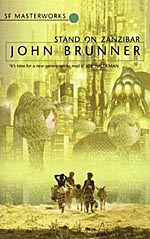
![]() Rhondak101
Rhondak101
12/16/2011
![]()
One reason I chose to read this book is because it appears on so many of the “best of” lists. I really did not know what to expect before I started because I had not read anything about it.
Written in 1967, the book is very postmodern in its arrangement. In fact, Brunner calls it a “non-novel” (586).The main narrative appears in the forty-two chapters labeled Continuity. Background and vignettes of minor characters appear in the thirty-two Tracking with Closeups chapters. Brunner presents artifacts of the book’s 2010 society in the twenty-nine Context chapters. The final kind of chapter is The Happening World. These sixteen chapters provide either artifacts similar to those in the Context chapters or snippets of headlines and other publications focused on a particular subject. This style is disconcerting at first. I found that these other chapters kinds of chapters delayed the narrative; therefore, it took me a while (about 200 pages) before I really cared about the characters in the book. Also, I learned quickly which Context and The Happening World chapters I wanted to skim (or skip altogether).
The main narrative paints an interesting dystopia that centers on population control. The title comes from the early 20th-century theory that the population of the whole world could stand shoulder-to-shoulder on the Isle of Wight. By Brunner’s time, the estimate was that the island would be the larger Isle of Man. Brunner believed that by 2010 the population would need an island the size of Zanzibar (more than three times the size of the Isle of Wight).
When reading a futuristic book set in our time, I always enjoy seeing which of the author’s predictions are correct. In Brunner’s 2010, all transportation in the developed world is public; marijuana is packaged and sold like cigarettes; and tobacco is illegal. However, where Brunner got it right is in his prediction that society will become ever more dependant (personally and economically) on media gadgetry. One of the best passages in the book shows this: “You know Chad’s definition of the New Poor? People who are too far behind with time-payments on next year’s model to make the downpayment on the one for the year after?” (285). The Chad mentioned in this passage is the fictional sociologist, Chad Mulligan. The excerpts from his “books” are some of the most interesting parts of Stand on Zanzibar.
Despite its format, the book is certainly worth a read. It provides much food for thought about our world and certainly paints an interesting picture of 1967’s preoccupations and worries.